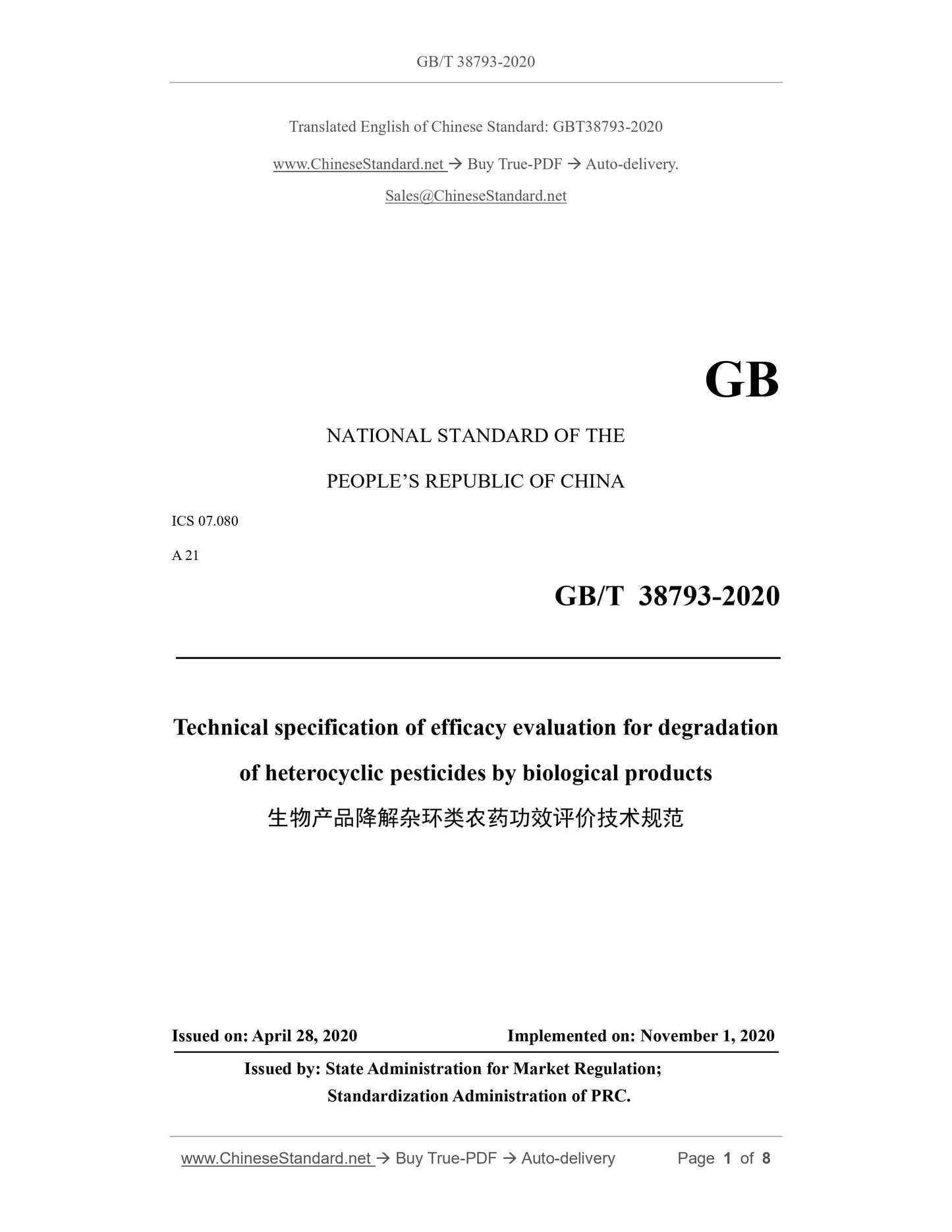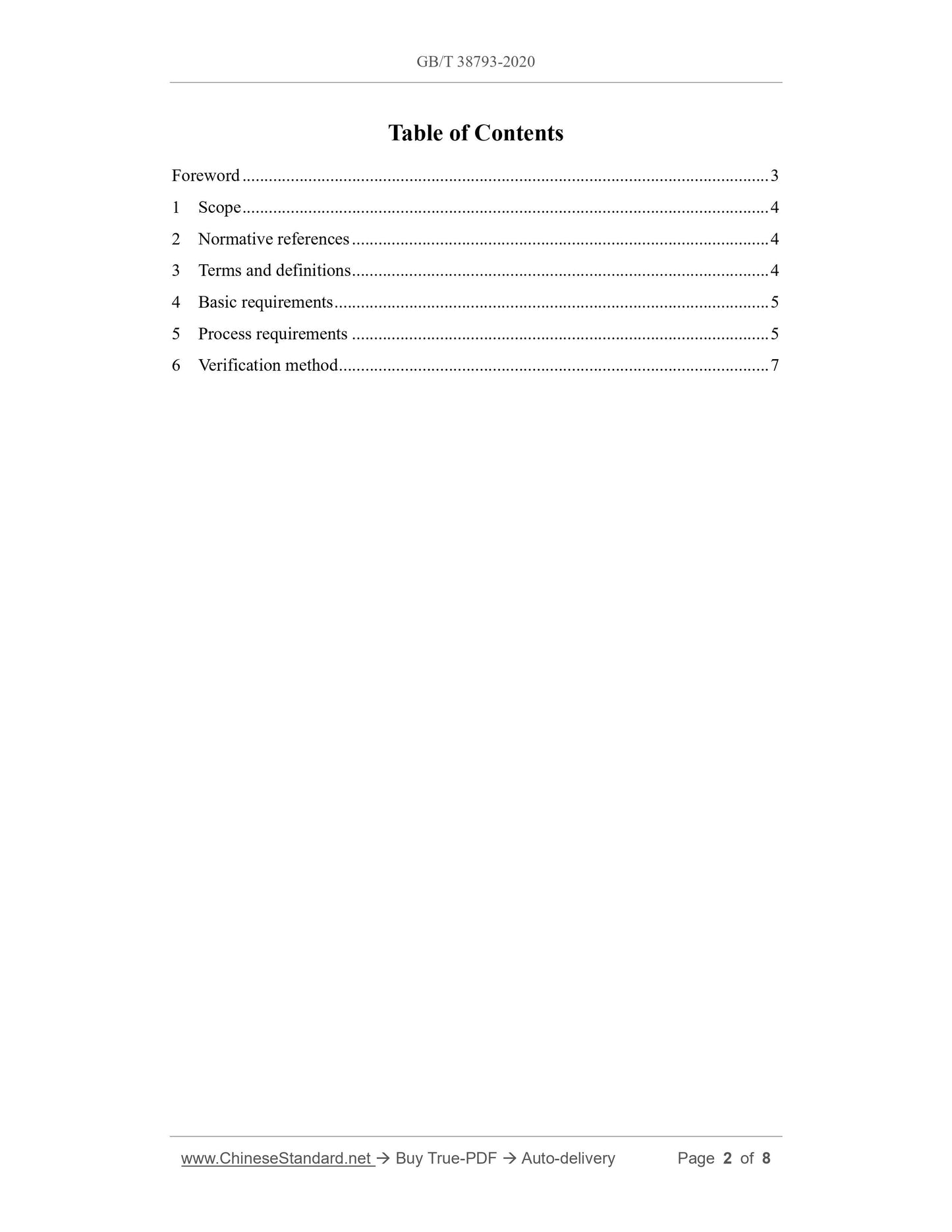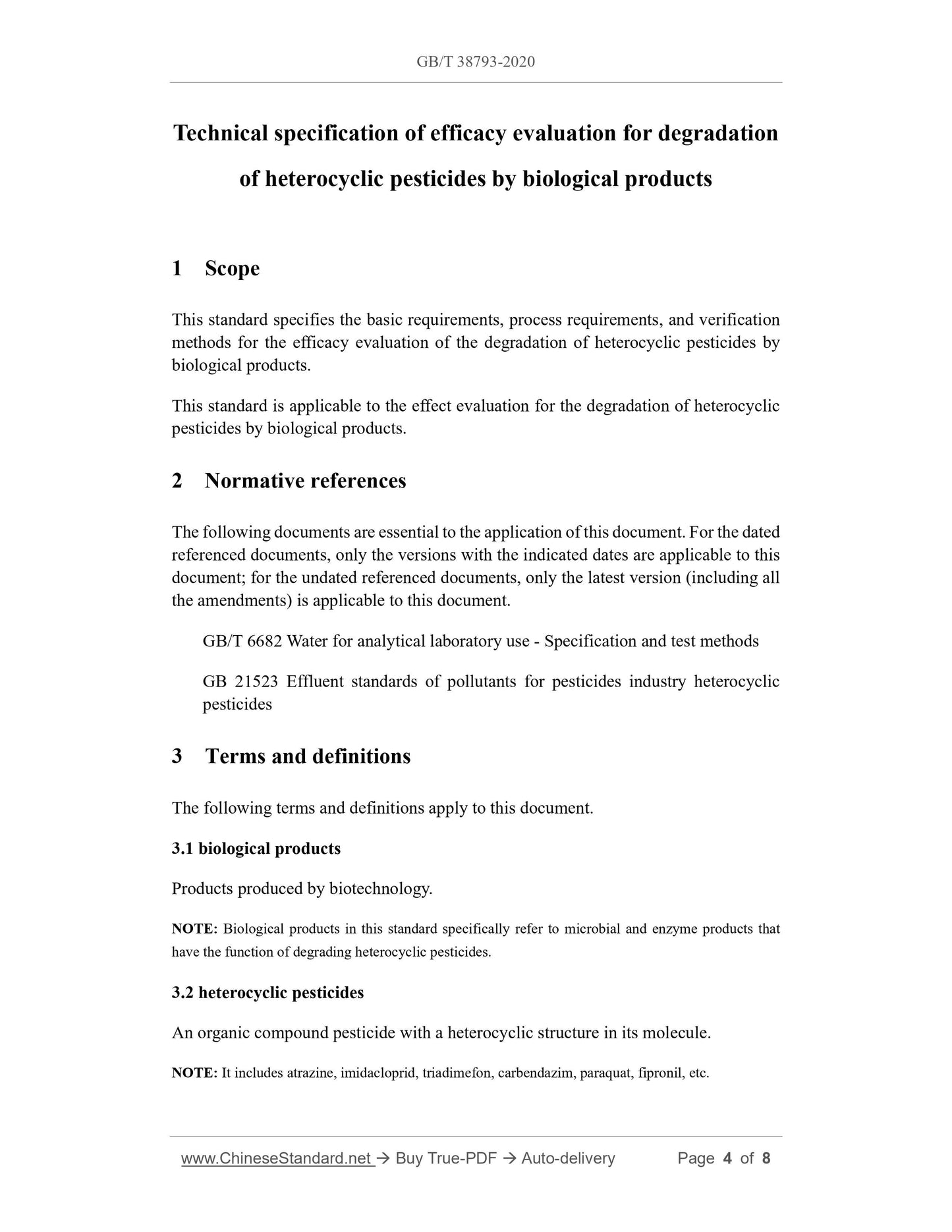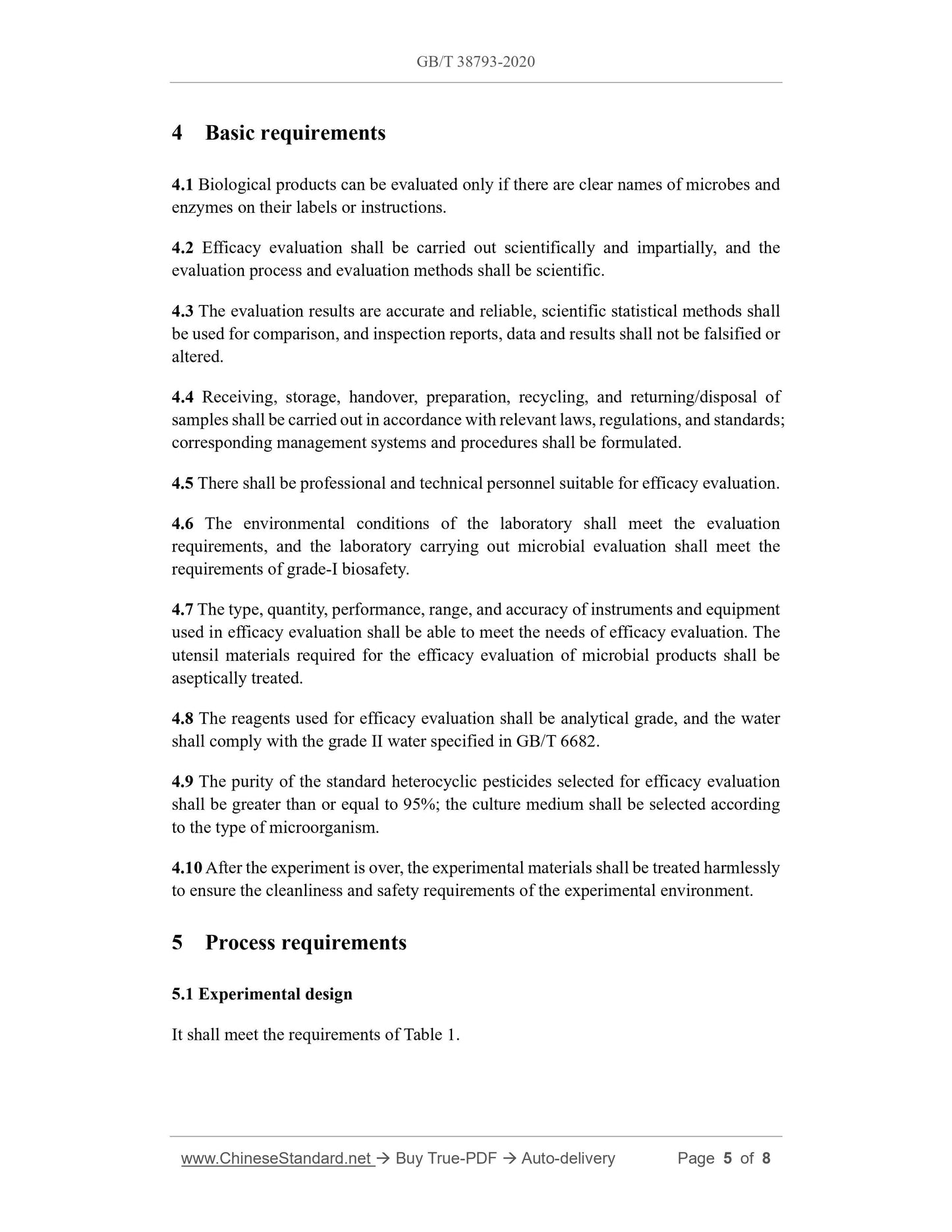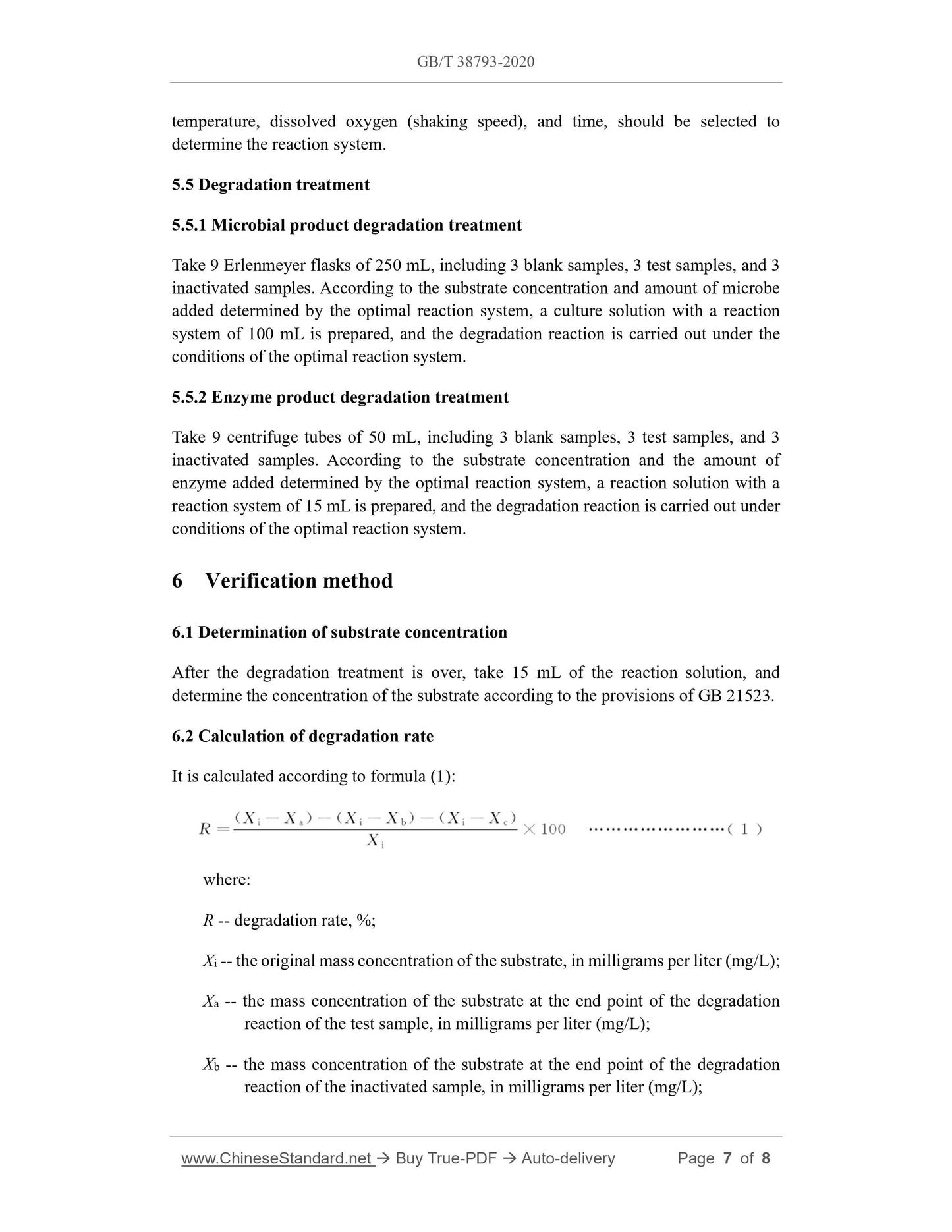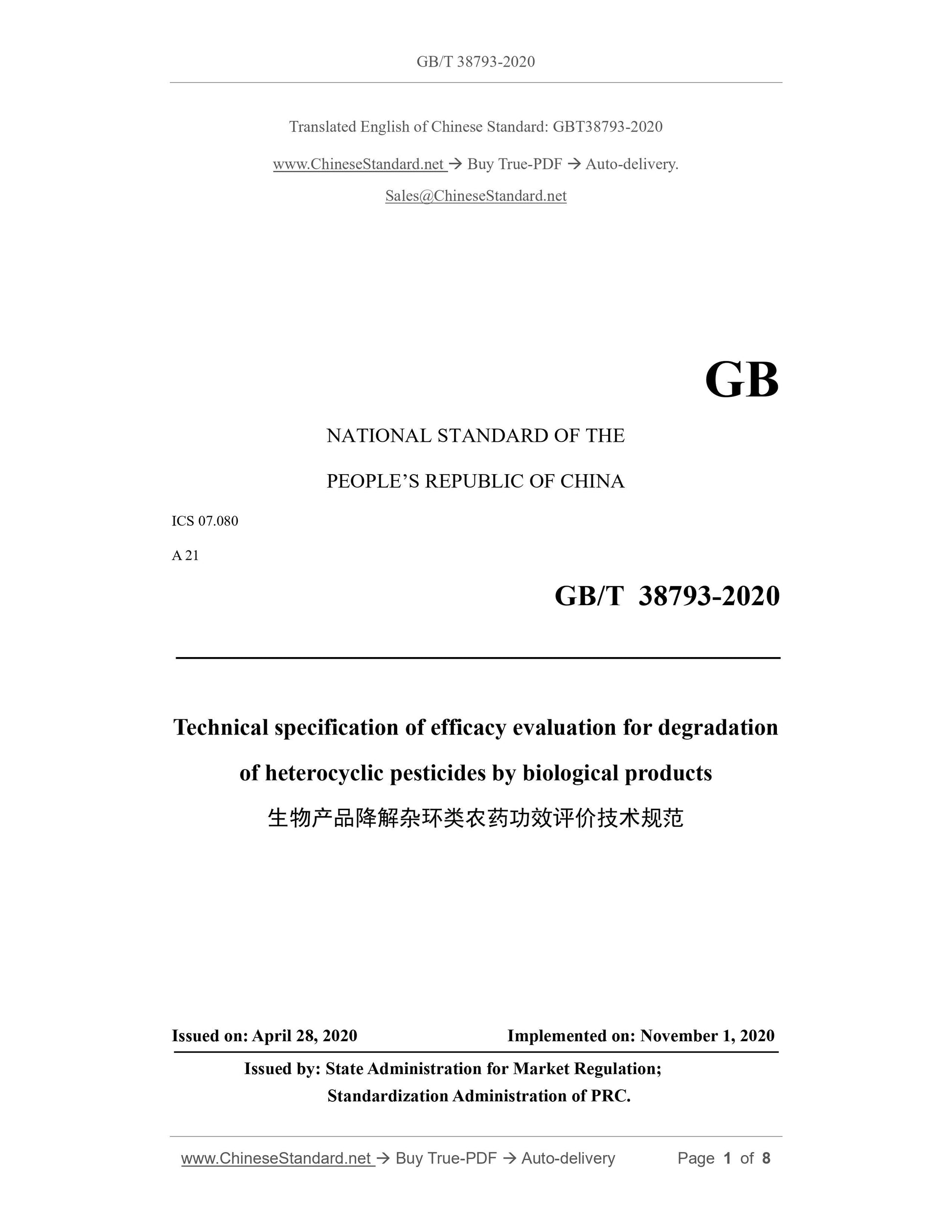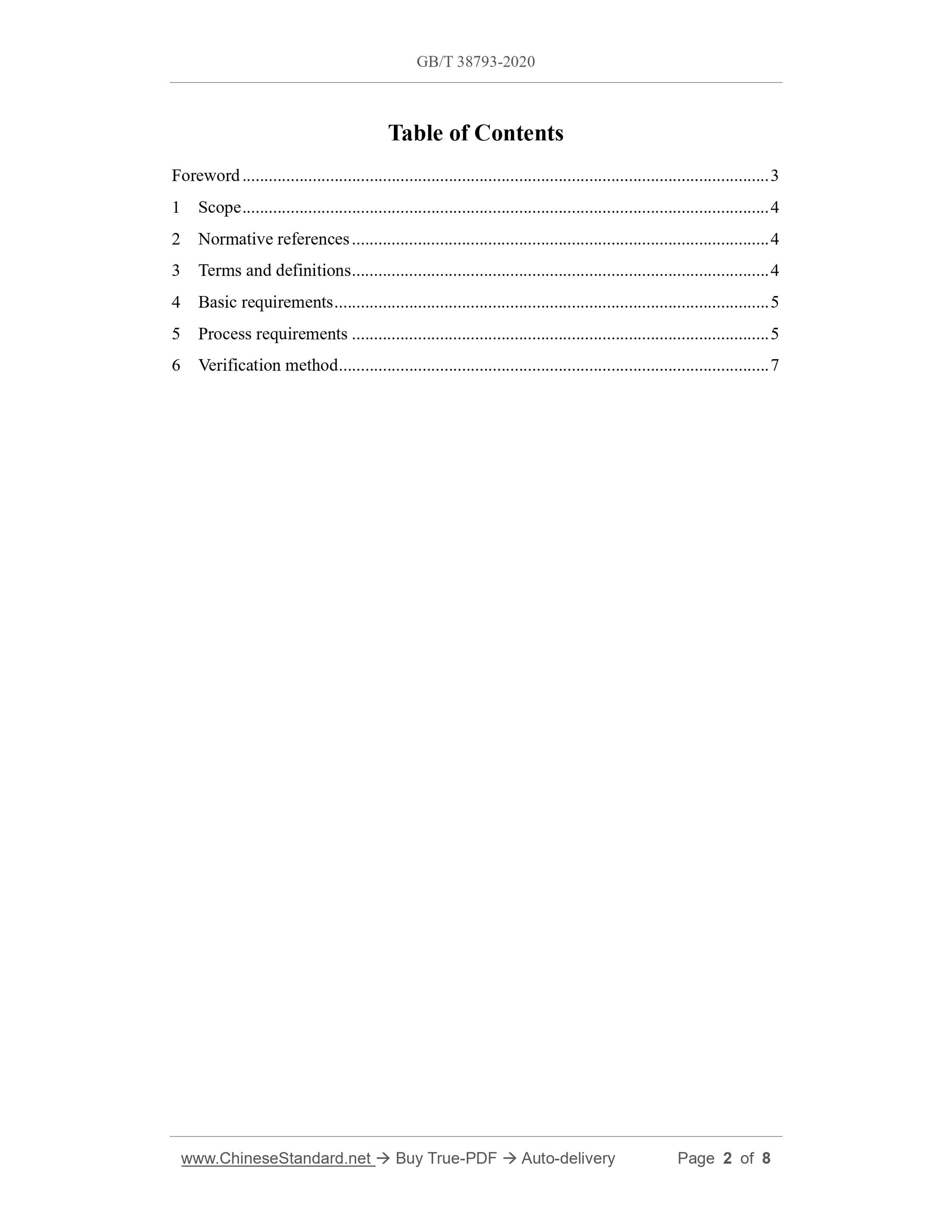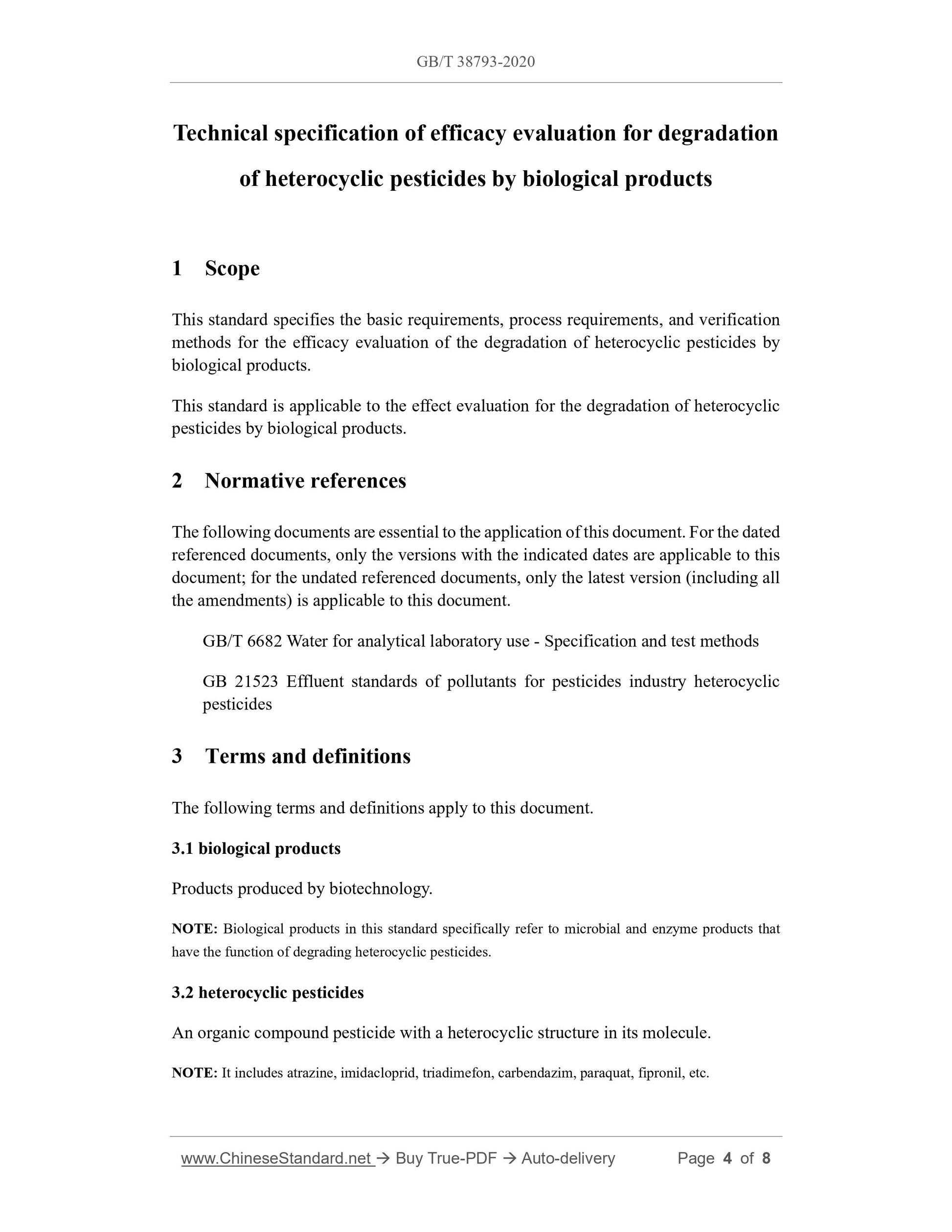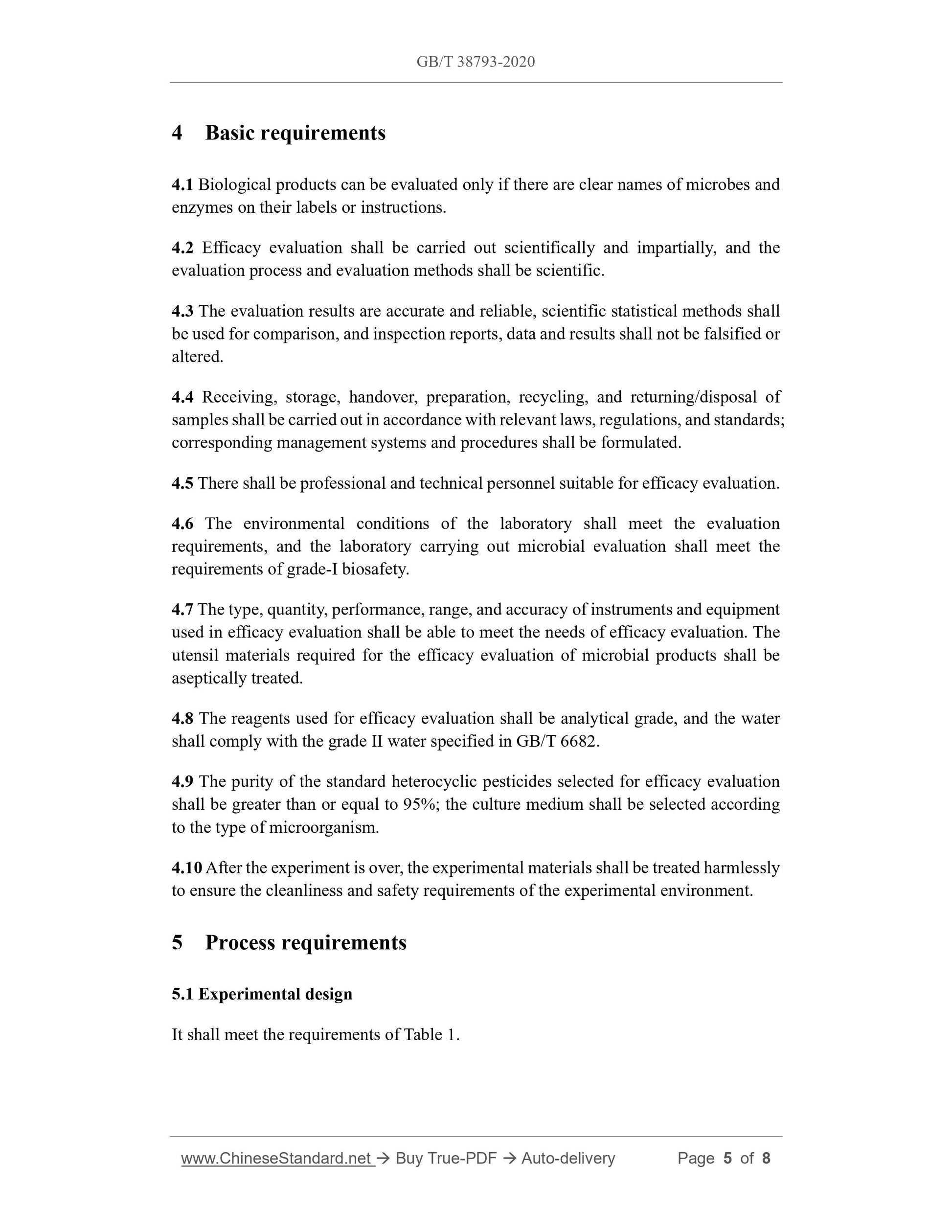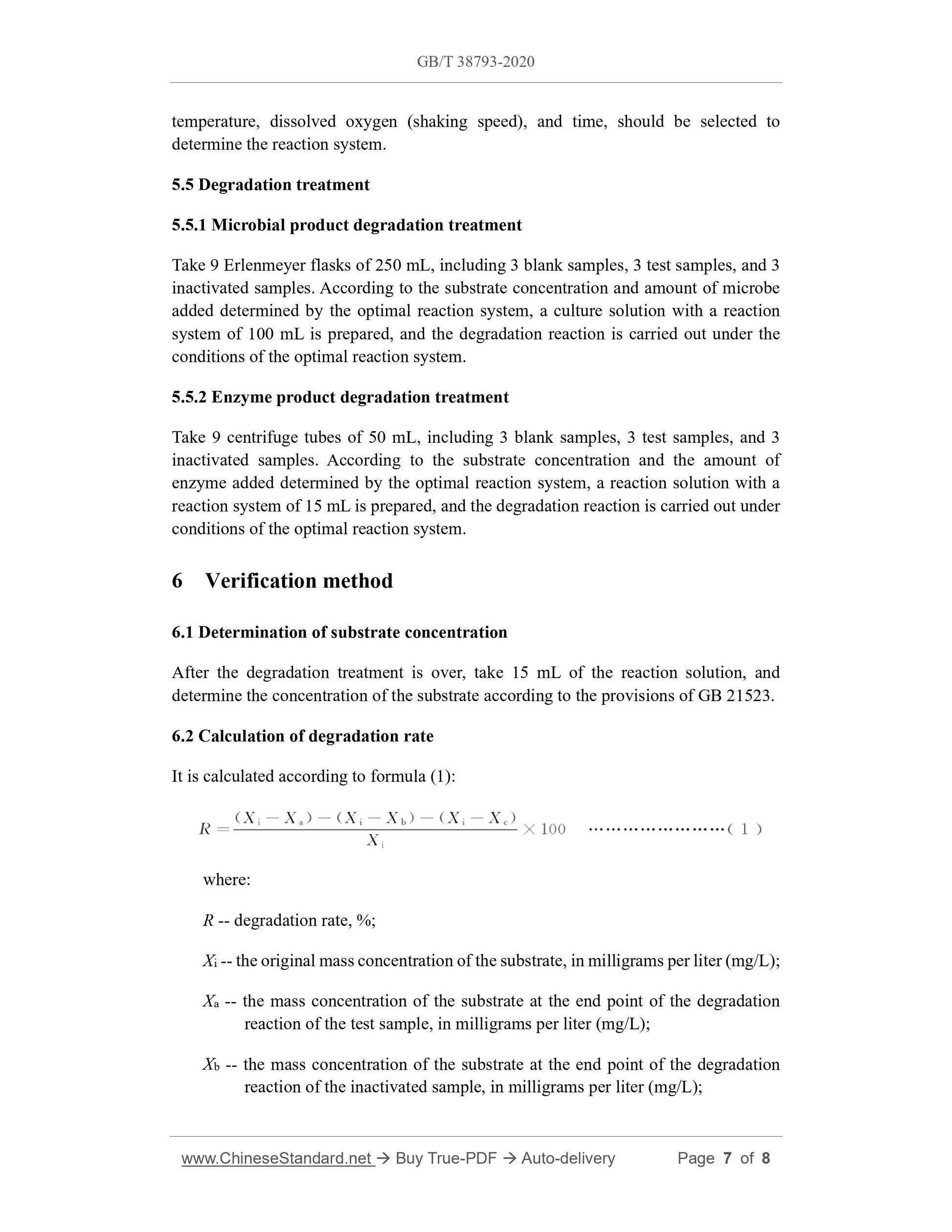1
/
of
5
PayPal, credit cards. Download editable-PDF and invoice in 1 second!
GB/T 38793-2020 English PDF (GBT38793-2020)
GB/T 38793-2020 English PDF (GBT38793-2020)
Regular price
$85.00 USD
Regular price
Sale price
$85.00 USD
Unit price
/
per
Shipping calculated at checkout.
Couldn't load pickup availability
Delivery: 3 seconds. Download true-PDF + Invoice.
Get QUOTATION in 1-minute: Click GB/T 38793-2020
Historical versions: GB/T 38793-2020
Preview True-PDF (Reload/Scroll if blank)
GB/T 38793-2020: Technical specification of efficacy evaluation for degradation of heterocyclic pesticides by biological products
GB/T 38793-2020
GB
NATIONAL STANDARD OF THE
PEOPLE’S REPUBLIC OF CHINA
ICS 07.080
A 21
Technical specification of efficacy evaluation for degradation
of heterocyclic pesticides by biological products
ISSUED ON: APRIL 28, 2020
IMPLEMENTED ON: NOVEMBER 1, 2020
Issued by: State Administration for Market Regulation;
Standardization Administration of PRC.
Table of Contents
Foreword ... 3
1 Scope ... 4
2 Normative references ... 4
3 Terms and definitions ... 4
4 Basic requirements ... 5
5 Process requirements ... 5
6 Verification method ... 7
Technical specification of efficacy evaluation for degradation
of heterocyclic pesticides by biological products
1 Scope
This standard specifies the basic requirements, process requirements, and verification
methods for the efficacy evaluation of the degradation of heterocyclic pesticides by
biological products.
This standard is applicable to the effect evaluation for the degradation of heterocyclic
pesticides by biological products.
2 Normative references
The following documents are essential to the application of this document. For the dated
referenced documents, only the versions with the indicated dates are applicable to this
document; for the undated referenced documents, only the latest version (including all
the amendments) is applicable to this document.
GB/T 6682 Water for analytical laboratory use - Specification and test methods
GB 21523 Effluent standards of pollutants for pesticides industry heterocyclic
pesticides
3 Terms and definitions
The following terms and definitions apply to this document.
3.1 biological products
Products produced by biotechnology.
NOTE: Biological products in this standard specifically refer to microbial and enzyme products that
have the function of degrading heterocyclic pesticides.
3.2 heterocyclic pesticides
An organic compound pesticide with a heterocyclic structure in its molecule.
NOTE: It includes atrazine, imidacloprid, triadimefon, carbendazim, paraquat, fipronil, etc.
4 Basic requirements
4.1 Biological products can be evaluated only if there are clear names of microbes and
enzymes on their labels or instructions.
4.2 Efficacy evaluation shall be carried out scientifically and impartially, and the
evaluation process and evaluation methods shall be scientific.
4.3 The evaluation results are accurate and reliable, scientific statistical methods shall
be used for comparison, and inspection reports, data and results shall not be falsified or
altered.
4.4 Receiving, storage, handover, preparation, recycling, and returning/disposal of
samples shall be carried out in accordance with relevant laws, regulations, and standards;
corresponding management systems and procedures shall be formulated.
4.5 There shall be professional and technical personnel suitable for efficacy evaluation.
4.6 The environmental conditions of the laboratory shall meet the evaluation
requirements, and the laboratory carrying out microbial evaluation shall meet the
requirements of grade-I biosafety.
4.7 The type, quantity, performance, range, and accuracy of instruments and equipment
used in efficacy evaluation shall be able to meet the needs of efficacy evaluation. The
utensil materials required for the efficacy evaluation of microbial products shall be
aseptically treated.
4.8 The reagents used for efficacy evaluation shall be analytical grade, and the water
shall comply with the grade II water specified in GB/T 6682.
4.9 The purity of the standard heterocyclic pesticides selected for efficacy evaluation
shall be greater than or equal to 95%; the culture medium shall be selected according
to the type of microorganism.
4.10 After the experiment is over, the experimental materials shall be treated harmlessly
to ensure the cleanliness and safety requirements of the experimental environment.
5 Process requirements
5.1 Experimental design
It shall meet the requirements of Table 1.
temperature, dissolved oxygen (shaking speed), and time, should be selected to
determine the reaction system.
5.5 Degradation treatment
5.5.1 Microbial product degradation treatment
Take 9 Erlenmeyer flasks of 250 mL, including 3 blank samples, 3 test samples, and 3
inactivated samples. According to the substrate concentration and amount of microbe
added determined by the optimal reaction system, a culture solution with a reaction
system of 100 mL is prepared, and the degradation reaction is carried out under the
conditions of the optimal reaction system.
5.5.2 Enzyme product degradation treatment
Take 9 centrifuge tubes of 50 mL, including 3 blank samples, 3 test samples, and 3
inactivated samples. According to the substrate concentration and the amount of
enzyme added determined by the optimal reaction system, a reaction solution with a
reaction system of 15 mL is prepared, and the degradation reaction is carried out under
conditions of the optimal reaction system.
6 Verification method
6.1 Determination of substrate concentration
After the degradation treatment is over, take 15 mL of the reaction solution, and
determine the concentration of the substrate according to the provisions of GB 21523.
6.2 Calculation of degradation rate
It is calculated according to formula (1):
where:
R -- degradation rate, %;
Xi -- the original mass concentration of the substrate, in milligrams per liter (mg/L);
Xa -- the mass concentration of the substrate at the end point of the degradation
reaction of the test sample, in milligrams per liter (mg/L);
Xb -- the mass concentration of the substrate at the end point of the degradation
reaction of the inactivated sample, in milligrams per liter (mg/L);
Get QUOTATION in 1-minute: Click GB/T 38793-2020
Historical versions: GB/T 38793-2020
Preview True-PDF (Reload/Scroll if blank)
GB/T 38793-2020: Technical specification of efficacy evaluation for degradation of heterocyclic pesticides by biological products
GB/T 38793-2020
GB
NATIONAL STANDARD OF THE
PEOPLE’S REPUBLIC OF CHINA
ICS 07.080
A 21
Technical specification of efficacy evaluation for degradation
of heterocyclic pesticides by biological products
ISSUED ON: APRIL 28, 2020
IMPLEMENTED ON: NOVEMBER 1, 2020
Issued by: State Administration for Market Regulation;
Standardization Administration of PRC.
Table of Contents
Foreword ... 3
1 Scope ... 4
2 Normative references ... 4
3 Terms and definitions ... 4
4 Basic requirements ... 5
5 Process requirements ... 5
6 Verification method ... 7
Technical specification of efficacy evaluation for degradation
of heterocyclic pesticides by biological products
1 Scope
This standard specifies the basic requirements, process requirements, and verification
methods for the efficacy evaluation of the degradation of heterocyclic pesticides by
biological products.
This standard is applicable to the effect evaluation for the degradation of heterocyclic
pesticides by biological products.
2 Normative references
The following documents are essential to the application of this document. For the dated
referenced documents, only the versions with the indicated dates are applicable to this
document; for the undated referenced documents, only the latest version (including all
the amendments) is applicable to this document.
GB/T 6682 Water for analytical laboratory use - Specification and test methods
GB 21523 Effluent standards of pollutants for pesticides industry heterocyclic
pesticides
3 Terms and definitions
The following terms and definitions apply to this document.
3.1 biological products
Products produced by biotechnology.
NOTE: Biological products in this standard specifically refer to microbial and enzyme products that
have the function of degrading heterocyclic pesticides.
3.2 heterocyclic pesticides
An organic compound pesticide with a heterocyclic structure in its molecule.
NOTE: It includes atrazine, imidacloprid, triadimefon, carbendazim, paraquat, fipronil, etc.
4 Basic requirements
4.1 Biological products can be evaluated only if there are clear names of microbes and
enzymes on their labels or instructions.
4.2 Efficacy evaluation shall be carried out scientifically and impartially, and the
evaluation process and evaluation methods shall be scientific.
4.3 The evaluation results are accurate and reliable, scientific statistical methods shall
be used for comparison, and inspection reports, data and results shall not be falsified or
altered.
4.4 Receiving, storage, handover, preparation, recycling, and returning/disposal of
samples shall be carried out in accordance with relevant laws, regulations, and standards;
corresponding management systems and procedures shall be formulated.
4.5 There shall be professional and technical personnel suitable for efficacy evaluation.
4.6 The environmental conditions of the laboratory shall meet the evaluation
requirements, and the laboratory carrying out microbial evaluation shall meet the
requirements of grade-I biosafety.
4.7 The type, quantity, performance, range, and accuracy of instruments and equipment
used in efficacy evaluation shall be able to meet the needs of efficacy evaluation. The
utensil materials required for the efficacy evaluation of microbial products shall be
aseptically treated.
4.8 The reagents used for efficacy evaluation shall be analytical grade, and the water
shall comply with the grade II water specified in GB/T 6682.
4.9 The purity of the standard heterocyclic pesticides selected for efficacy evaluation
shall be greater than or equal to 95%; the culture medium shall be selected according
to the type of microorganism.
4.10 After the experiment is over, the experimental materials shall be treated harmlessly
to ensure the cleanliness and safety requirements of the experimental environment.
5 Process requirements
5.1 Experimental design
It shall meet the requirements of Table 1.
temperature, dissolved oxygen (shaking speed), and time, should be selected to
determine the reaction system.
5.5 Degradation treatment
5.5.1 Microbial product degradation treatment
Take 9 Erlenmeyer flasks of 250 mL, including 3 blank samples, 3 test samples, and 3
inactivated samples. According to the substrate concentration and amount of microbe
added determined by the optimal reaction system, a culture solution with a reaction
system of 100 mL is prepared, and the degradation reaction is carried out under the
conditions of the optimal reaction system.
5.5.2 Enzyme product degradation treatment
Take 9 centrifuge tubes of 50 mL, including 3 blank samples, 3 test samples, and 3
inactivated samples. According to the substrate concentration and the amount of
enzyme added determined by the optimal reaction system, a reaction solution with a
reaction system of 15 mL is prepared, and the degradation reaction is carried out under
conditions of the optimal reaction system.
6 Verification method
6.1 Determination of substrate concentration
After the degradation treatment is over, take 15 mL of the reaction solution, and
determine the concentration of the substrate according to the provisions of GB 21523.
6.2 Calculation of degradation rate
It is calculated according to formula (1):
where:
R -- degradation rate, %;
Xi -- the original mass concentration of the substrate, in milligrams per liter (mg/L);
Xa -- the mass concentration of the substrate at the end point of the degradation
reaction of the test sample, in milligrams per liter (mg/L);
Xb -- the mass concentration of the substrate at the end point of the degradation
reaction of the inactivated sample, in milligrams per liter (mg/L);
Share
